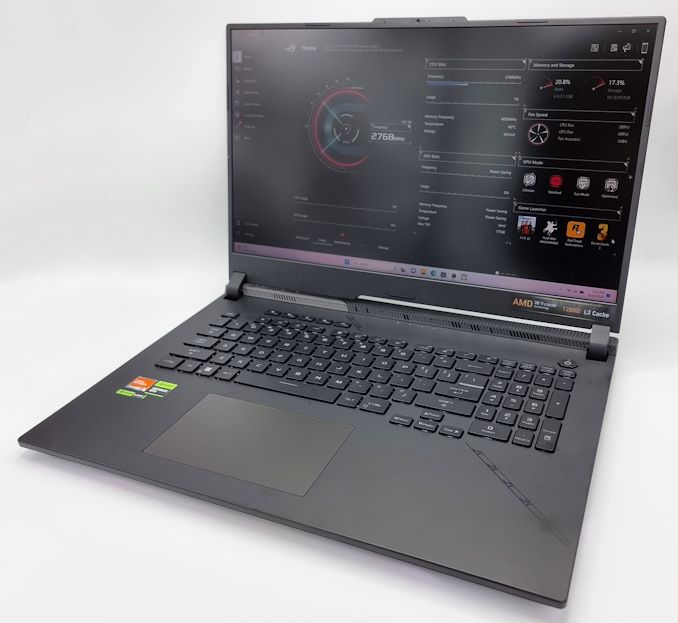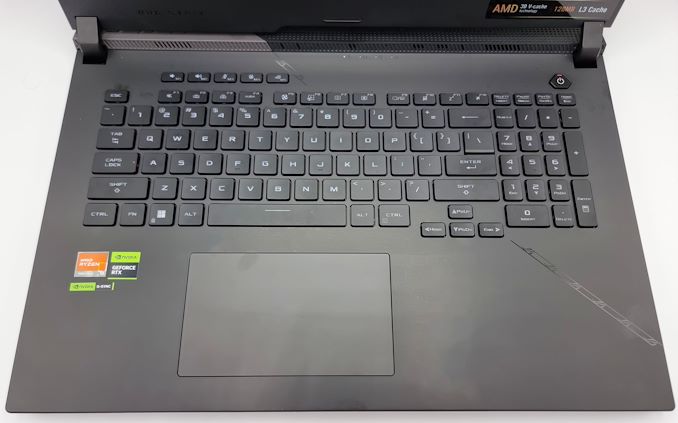The ASUS ROG Strix Scar 17 (2023) Laptop Review: Mobile Ryzen 9 7945HX3D with 3D V-Cache Impresses
by Gavin Bonshor on August 22, 2023 9:00 AM ESTASUS ROG Strix Scar 17: Design and Closer Look
Moving onto the design of the ROG Strix Scar 17 gaming notebook, the first thing I was drawn to was the plastic finish. Even with the primarily plastic frame it doesn't feel cheap, and it still has a pretty hefty weight sitting at 3 kg without the power brick. At 395.5 x 282 x 23.4 mm (W x D x H) it's by no means a small laptop, either. It's certainly more portable and malleable in where it can be put compared to a desktop. Still, adding 3 KG into a backpack and the enormous power brick will undoubtedly be much more noticeable than, say, a netbook or a notebook like a Razer Blade 14.
We can see it in all its glory by opening up the aluminum lid of the ROG Strix Scar 17. It's certainly a sleek and typically quaint gaming notebook on the surface. It has a customizable RGB keyboard and can be synced up with the RGB lightbar at the front, providing a bit of pop and glow to the underside. The keyboard also feels good, with a bit of feedback and bounce on key presses, although not to the standard of a mechanical keyboard with tactile and clicky switches. Users can customize the RGB LEDs, which are located in a stylish light bar along the bottom, and each key can be customized to a different color as per what the user wants.
The display looks good to the eye and is pretty vibrant. For a 17.3-inch with a 2560 x 1440p (16:9) resolution and a 240 Hz refresh rate, all within an IPS panel, it's certainly good enough for gamers looking to switch to a sleeker and more portable powerhouse. Although 4K is all the rage, it's not a necessity to include, and for a 240 Hz panel, any game outside of well-optimized eSports titles and possibly much older games aren't even going to cut it at such high resolutions. Basically, we're saying here that a 1440p 240 Hz panel with an RTX 4090 and the latest Ryzen 9 7945HX3D is more than acceptable, especially given limitations in the amount of hardware that can be put inside such a small space.
As previously mentioned, ASUS includes a basic 720p webcam along the top bezel, which isn't awe-inspiring. For a 'true' desktop replacement, we would have expected something with a bit more prowess, especially given how popular game streaming is nowadays.
Despite being made primarily from plastic, the top lid is coated with aluminum and, as such, feels premium. Even the hinges connecting the display to the chassis feel good, and we have no fears about reliability or quality issues here. Given the large frame versus say, a 13 or 14-inch notebook, ASUS has put a separate power button above the keyboard, and the dual speakers are housed between the keyboard and the display.
Most of the ROG Strix Scar 17's connectivity is on the rear, with two USB 3.2 Gen 2 Type-C ports, an HDMI 2.1 video output, and a 2.5 GbE port sandwiched between two air vents. There's also a universal power input for the 330 W AC power brick, which allows users to charge the laptop's battery.
There are no inputs on the right side of the Scar 17, only an air vent, so the remaining connectors are located on the left-hand side, which also has a similar air vent. On the left side are two USB 3.2 Gen 1 Type-A ports and a 3.5 mm combo audio jack.
There's no denying that the ROG Strix Scar 17 is a stylish and premium-looking gaming notebook, but there's also the fact that ASUS is using a lot of plastic for such an expensive gaming notebook. While it doesn't quite have that elegant and premium feel of a Razer Blade or a MacBook Air, much of ASUS's focus is clearly on delivering performance, and that's understandable.
That's not to say it doesn't 'feel' premium; it's just that for a $3000+ gaming notebook, some users may critique the use of so much plastic. That being said, being a desktop replacement designed to be tethered to a desk instead of a gaming PC, these notebooks typically don't move around as much as ultraportable laptops, so they can be slightly heavier and bulkier and get away with it.
ASUS ROG Strix Scar 17: Software
Before we get down to the meat and potatoes of the review (the performance), we wanted to highlight the software bundle packaged with the Strix Scar 17. ASUS's software revolves around Armory Crate, which is a plus point, as it rolls everything into one primary application.
The ASUS Armory Crate software provides a multitude of customizations across a variety of areas, including and not just limited to RGB lighting, adjusting and setting fan profiles, setting macro keys, game visuals, and even per-key RGB LED customizations through AURA, which can be synced with other compatible devices too.
Perhaps the most functional and practical area of Armory Crate is the performance modes or the ability to cycle through the performance-enhancing profiles on offer. The first of these is called Ultimate, designed to ramp things up for maximum performance and, consequently, will also use more power. Standard is designed to balance performance when needed while trying to conserve battery life where it can. In contrast, Eco mode is designed primarily to reduce gaming performance, so battery life is prolonged. Depending on the task, the Optimized profile automatically switches between standard and eco modes.
On the following pages, we'll dive into the performance of not only the ROG Strix Scar 17 as it is, but we'll also be looking at how well the AMD Ryzen 9 7945HX3D with 3D V-Cache stacks up in terms of compute and gaming performance.



























23 Comments
View All Comments
blkspade - Saturday, September 2, 2023 - link
With the exception of having decent built-in speakers, literally no one that genuinely cares about audio relies on any computers built-in audio interface. Recent Realtek chips like the ALC1220 is actually not even a terrible audio chip, but it matters more how its implemented as an onboard solution. If you were going to do any sort of production, you'd always use an external interface anyway. Audiophiles will have a preferred DAC, since no computer at any price is likely to have anything built-in that's comparable. Most of the people such a laptop targets are going to be using some relatively crappy USB gaming headset completely bypassing the analog interface.Your only real options for built-in solutions are Intel, Realtek and Marvell. Intel's recent 2.5Gb NIC has been problematic, to the point where Realtek was probably the superior solution. Marvell Acquantia based 10Gbe NICs have been better than the one Intel 10Gbe I bought. Unless you're using the laptop as a server, you probably aren't running into issues where it being a Realtek chip is the problem. I get the full and expected performance out of the Realtek 1Gb NIC in my $1200 laptop, and I'm frequently transferring data to/from the server at work. I haven't run into a problematic or poor performing Realtek NiC in a while, outside of maybe a USB one. This will handle your typical steam updates just fine. Your opinions are clearly based on long outdated knowledge/experience.
Duncan Macdonald - Tuesday, August 22, 2023 - link
Any laptop with a 720p (or worse!!) camera advertises that penny pinching occurred in the design.As you can get FHD (1080p) on even a £60 Android phone the price difference to the maker of 720p and 1080p cameras must be minimal. I take the presence of a low resolution camera as a warning that there is likely to be penny pinching with important components (eg the battery). As such I will not buy a laptop that does not have at least a FHD camera.
Besides the penny pinching aspect - a FHD camera is useful if you want to show an A4 document to someone on a video call (720p cameras blur the text too much if you try to get a full A4 page into a single picture).
brucethemoose - Tuesday, August 22, 2023 - link
The 1st gen G14 didn't even have a webcam!I guess its not a priority for gaming focused designs?
Makaveli - Wednesday, August 23, 2023 - link
With you on the webcam even if you don't use it much you know it would cost them a few extra bucks to make it 1080p........lemurbutton - Wednesday, August 23, 2023 - link
The biggest constraint for a webcam on a laptop is the thinness of the lid. Phones are significantly thicker than the lid of a laptop. That's why Macbooks have a notch. It's also why some laptop makers have tried putting the webcam at the bottom of the lid.ballsystemlord - Tuesday, August 22, 2023 - link
It's unfortunate that there is no DVD drive. DVDs are still popular and M-Disks are the ultimate cold storage solution.back2future - Wednesday, August 23, 2023 - link
since pretty much high-top components and performance, "while there are two USB 3.2 Gen 2 Type-C ports and two USB 3.2 Gen 1 Type-A ports", wondering about USB 4 hubs availableDVDs with option for external drive, what would not saturate USB3.2 connections, if there's no need for mobile access for optical storage ~100GB, 12x avg(25GB disc) ~35MB/s (~25-54MB/s, ~USB2.0 almost sufficient for 12x data transfer) (ODA, ~5.5TB each cartridge (11discs), discontinued product, Sony 2022 (next), wr ~185/370MB/s, ~50-100plus years data access, HDDs ~5-25yrs)
James5mith - Wednesday, August 23, 2023 - link
Weird that they ship this with DDR5-4800, not 5600. Wonder why that is? Just a small way to try and save some power I guess? But since both run at JEDEC 1.1v, what's the major difference?garblah - Wednesday, August 23, 2023 - link
Strange that OLED panels aren't standard on these top of the line notebooks yet. I would far prefer a 120hz OLED to a 240hz IPS, even if the primary use is gaming and the resolution only 1440p. Something about backlight bleed on the best notebook IPS makes it even more noticeable than desktop displays.peevee - Wednesday, August 23, 2023 - link
There are a bunch of all-important questions for laptop owners which you just ignore.Is battery user-replaceable? Are replacement batteries available? How much do they cost? What about 3rd party batteries? Are they still going to be available in 2,4,6,8 years?
Is memory user-replaceable? Is SSD?
If you just test it it might not matter. If you plan to use it for more than 2 years these matter way more than fps over 60 (given that progress has slowed to a crawl a laptop like this is not even be outdated in 10 years)